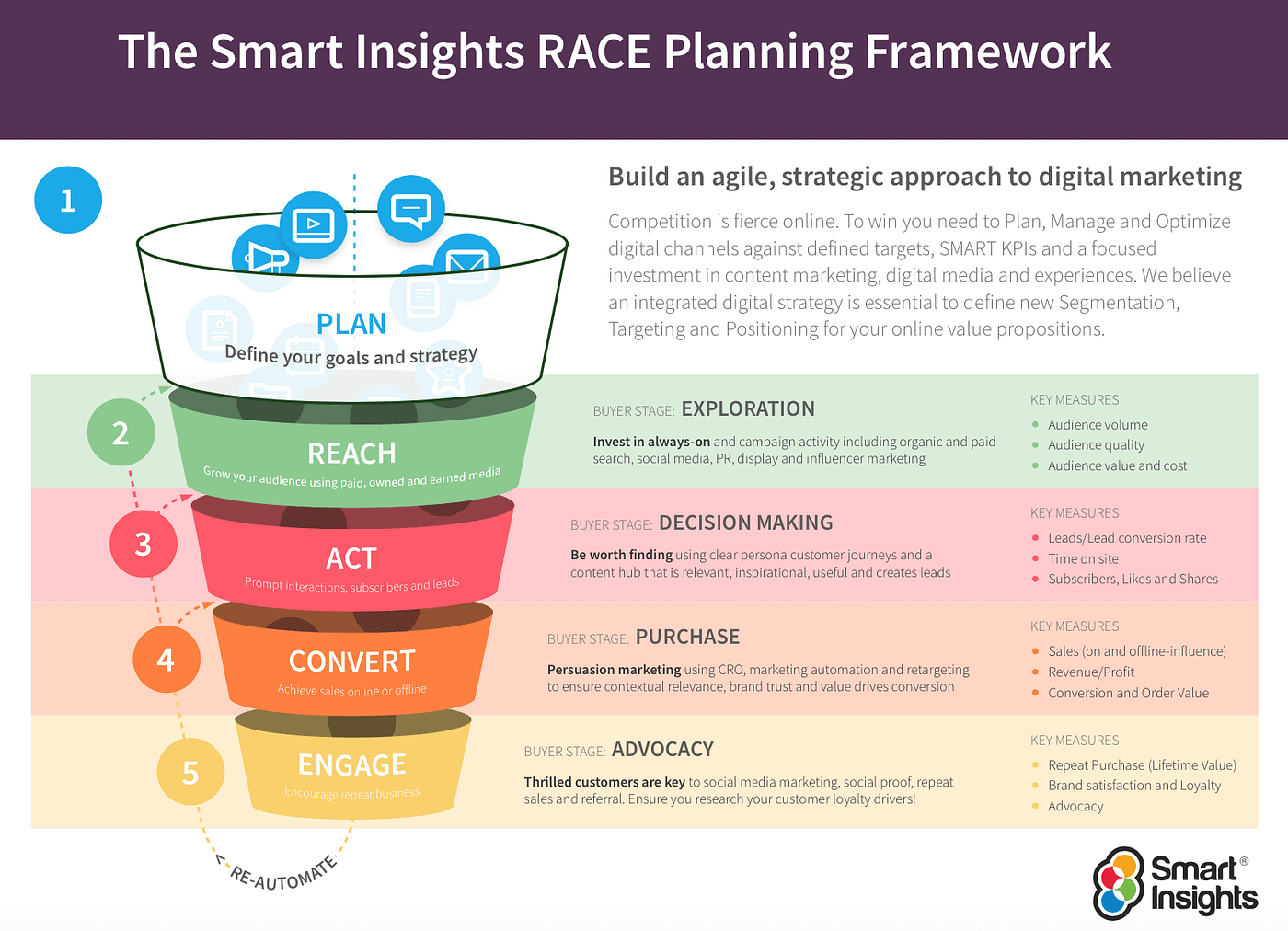The RACE Framework is a strategic model designed to guide businesses through the entire customer journey, from brand awareness to post-purchase engagement.

It stands for Reach, Act, Convert, and Engage, and it’s widely used in digital marketing to structure and optimize campaigns effectively. Each phase focuses on a different stage of the customer journey, ensuring that you address the right needs and behaviors at the right time.
1. REACH: Building Brand Awareness
The Reach phase is all about making potential customers aware of your brand, products, or services. The goal here is to get your brand in front of as many relevant people as possible. This is the top of the marketing funnel, where you attract new visitors and create initial interest.
Key Strategies:
- Social Media Campaigns: Use consistent, valuable, and engaging posts across social platforms to reach a broader audience. A well-planned content calendar ensures regular visibility and builds familiarity with your brand.
- Paid Advertising: Invest in visibility-driven ad campaigns, such as display ads, social media ads, or Google Ads, targeting your homepage or a high-level category page.
- External Email Campaigns: To introduce your brand to a new audience, send promotional emails to external databases, ideally segmented based on buyer personas.
Practical Example:
Imagine you’re launching a new line of eco-friendly shoes. To build awareness, you run a series of Instagram ads featuring your product benefits, paired with engaging content about sustainability. At the same time, you launch a blog on your website that covers topics like eco-conscious fashion. By combining paid ads and valuable content, you gradually build interest and establish your brand in the minds of your target audience.
2. ACT: Generating Interest and Consideration
In the Act phase, potential customers who have become aware of your brand begin to show interest and evaluate your products or services. They might browse your website, compare your offerings with competitors, or seek additional information to determine whether your brand fits their needs.
Key Strategies:
- Remarketing Campaigns: Use remarketing ads to target visitors who’ve interacted with your website but haven’t yet converted. These ads keep your brand top-of-mind while they consider their options.
- Customer Reviews and Testimonials: Highlight reviews, ratings, and testimonials on your product pages or social profiles to build trust and credibility.
- Affiliate Marketing: Collaborate with influencers or niche blogs that align with your industry to feature your products and direct traffic to your website.
Practical Example:
Continuing with the eco-friendly shoe brand, let’s say someone visits your website but doesn’t make a purchase. You set up a remarketing campaign that shows them ads for your shoes on Facebook, showcasing customer testimonials and detailed product reviews. Additionally, you partner with a sustainability blog to write a feature about your shoes, linking back to your site. These strategies reinforce your brand’s value and encourage potential customers to return and consider making a purchase.
3. CONVERT: Driving Sales and Transactions
The Convert phase focuses on getting customers to complete a purchase or take a meaningful action like signing up for a service. At this point, they’ve moved from considering your offer to being ready to buy, but they might still need some nudging to cross the finish line.
Key Strategies:
- Conversion-Focused Landing Pages: Create landing pages optimized for conversion, with clear calls-to-action, limited distractions, and all the information customers need to make a decision.
- Shopping Campaigns: Utilize Google Shopping Ads or similar platforms to display your products prominently in search results, driving traffic directly to purchase pages.
- Abandoned Cart Emails: Set up automated emails to remind customers about items left in their carts, offering incentives like discounts or free shipping to encourage completion.
Practical Example:
For the eco-friendly shoe brand, you run a Google Shopping campaign targeting search terms like “best sustainable shoes.” These ads lead directly to a product page optimized with high-quality images, concise product descriptions, and a prominent “Buy Now” button. Additionally, if someone adds shoes to their cart but doesn’t complete the purchase, they receive a personalized email offering a 10% discount as an incentive to return and finalize the order.
4. ENGAGE: Building Loyalty and Advocacy
The Engage phase is where you focus on retaining customers and turning them into repeat buyers or brand advocates. Post-purchase engagement is crucial for driving long-term value and fostering customer loyalty, which is often more cost-effective than constantly acquiring new customers.
Key Strategies:
- Loyalty Programs: Implement a rewards program where customers earn points for every purchase, which can be redeemed for discounts or exclusive products.
- Post-Purchase Communication: Send personalized follow-up emails after a purchase, offering tips on how to get the most out of the product, asking for reviews, or providing recommendations for related products.
- Community Building: Create and nurture a brand community, whether through social media groups, forums, or events, where customers can connect with each other and deepen their relationship with your brand.
Practical Example:
After someone buys a pair of your eco-friendly shoes, they receive an email thanking them for their purchase, along with tips on how to care for their shoes to extend their lifespan. They also receive an invitation to join your loyalty program to earn points for future purchases. Over time, you send targeted offers, like discounts on new arrivals or early access to limited-edition products. By keeping your brand top-of-mind and rewarding loyalty, you increase the likelihood of repeat purchases.
Why the RACE Framework is Effective for Digital Marketing
The RACE Framework offers a comprehensive approach to managing the customer journey, from the first interaction to ongoing engagement. By aligning your marketing strategies with each stage—Reach, Act, Convert, and Engage—you can build a cohesive, data-driven plan that maximizes your brand’s visibility, drives conversions, and builds lasting customer relationships.
Whether you’re running a small business or managing a large eCommerce operation, integrating the RACE Framework into your digital marketing strategy ensures that every stage of the customer journey is addressed, ultimately leading to sustainable growth and increased profitability.
